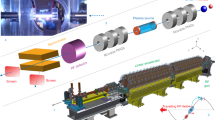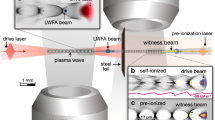Abstract
Plasmas excited by laser beams or bunches of relativistic electrons have been used to produce electric fields of 10–100 GV m−1. This has opened up the possibility of building compact particle accelerators at the gigaelectronvolt scale. However, it is not obvious how to scale these approaches to the energy frontier of particle physics—the teraelectronvolt regime. Here, we introduce the possibility of proton-bunch-driven plasma-wakefield acceleration, and demonstrate through numerical simulations that this energy regime could be reached in a single accelerating stage.
This is a preview of subscription content, access via your institution
Access options
Subscribe to this journal
Receive 12 print issues and online access
$209.00 per year
only $17.42 per issue
Buy this article
- Purchase on Springer Link
- Instant access to full article PDF
Prices may be subject to local taxes which are calculated during checkout




Similar content being viewed by others
Change history
24 April 2009
In the version of this article originally published online, in the first equation of the section 'Initial considerations', the denominator was mistakenly not included within the square-root sign. This has been corrected in all versions of the article.
References
Budker, G. I. Proc. CERN Symp. on High-Energy Accelerators and Pion Physics 68–75 (1956).
Veksler, V. I. Proc. CERN Symp. on High-Energy Accelerators and Pion Physics 80–83 (1956).
Fainberg, Ya. B. Proc. CERN Symp. on High-Energy Accelerators and Pion Physics 84–90 (1956).
Tajima, T. & Dawson, J. M. Laser electron accelerator. Phys. Rev. Lett. 43, 267–270 (1979).
Joshi, C. et al. Forward Raman instability and electron acceleration. Phys. Rev. Lett. 47, 1285–1288 (1981).
Kitagawa, Y. et al. Beat-wave excitation of plasma wave and observation of accelerated electrons. Phys. Rev. Lett. 68, 48–51 (1992).
Nakajima, K. et al. in Advanced Accelerator Concepts, AIP Conference Proceedings Vol. 335 (ed. Schoessow, P.) 145–155 (AIP Press, 1995).
Leemans, W. P. et al. GeV electron beams from a centimetre-scale accelerator. Nature Phys. 2, 696–699 (2006).
Chen, P., Dawson, J. M., Huff, R. W. & Katsouleas, T. Acceleration of electrons by the interaction of a bunched electron beam with a plasma. Phys. Rev. Lett. 54, 693–708 (1985).
O’Connell, C. L. et al. Plasma production via field ionization. Phys. Rev. ST Accel. Beams 9, 101301 (2006).
Muggli, P. et al. Meter-scale plasma-wakefield accelerator driven by a matched electron beam. Phys. Rev. Lett. 93, 014802 (2004).
Lee, S. et al. Plasma-wakefield acceleration of a positron beam. Phys. Rev. E 64, 045501 (2001).
Blumenfeld, I. et al. Energy doubling of 42 GeV electrons in a metre-scale plasma wakefield accelerator. Nature 445, 741–744 (2007).
Ruth, R. D., Chao, A. W., Morton, P. L. & Wilson, P. B. A plasma wake-field accelerator. Part. Accel. 17, 171–189 (1985).
Chen, P., Su, J. J., Dawson, J. M., Bane, K. L. & Wilson, P. B. On energy transfer in the plasma wakefield accelerator. Phys. Rev. Lett. 56, 1252–1255 (1986).
Esarey, E., Sprangle, P., Krall, J. & Ting, A. Overview of plasma-based accelerator concepts. IEEE Trans. Plasma Sci. 24, 252–288 (1996).
Joshi, C. Plasma accelerators. Sci. Am. 294, 41–47 (2006).
Joshi, C. The development of laser- and beam-driven plasma accelerators as an experimental field. Phys. Plasmas 14, 055501 (2007).
Katsouleas, T. Plasma physics: On the node of a wave. Nature 444, 688–689 (2006).
Lotov, K. V. Blowout regimes of plasma wakefield acceleration. Phys. Rev. E 69, 046405 (2004).
Kallos, E. et al. High-gradient plasma-wakefield acceleration with two subpicosecond electron bunches. Phys. Rev. Lett. 100, 074802 (2008).
Blue, B. E. et al. Parametric exploration of intense positron beam-plasma interactions. Laser Part. Beams 21, 497–504 (2003).
Zhou, C. T. et al. A comparison of ultrarelativistic electron- and positron-bunch propagation in plasmas. Phys. Plasmas 13, 092109 (2006).
Hogan, M. J. et al. Ultrarelativistic-positron-beam transport through meter-scale plasmas. Phys. Rev. Lett. 90, 205002 (2003).
Blue, B. E. et al. Plasma-wakefield acceleration of an intense positron beam. Phys. Rev. Lett. 90, 214801 (2003).
Blue, B. E. Plasma Wakefield Acceleration of an Intense Positron Beam. Thesis, UCLA (2003).
Lu, W., Huang, C., Zhou, M. M. & Mori, W. B. Limits of linear plasma wakefield theory for electron or positron beams. Phys. Plasmas 12, 063101 (2005).
Lotov, K. V. Efficient operating mode of the plasma wakefield accelerator. Phys. Plasmas 12, 053105 (2005).
Eichner, T. et al. Miniature magnetic devices for laser-based, table-top free-electron lasers. Phys. Rev. ST Accel. Beams 10, 082401 (2007).
Pukhov, A. & Kostyukov, I. Control of laser wake field acceleration by plasma density profile. Phys. Rev. E 77, 025401 (2008).
Agostinelli, S., et al. [Geant4 Collaboration]Nucl. Instrum. Methods A 506, 250–303 (2003).
Pukhov, A. Three-dimensional electromagnetic relativistic particle-in-cell code VLPL (Virtual Laser Plasma Lab). J. Plasma Phys. 61, 425–433 (1999).
Lotov, K. V. Fine wakefield structure in the blowout regime of plasma wakefield accelerators. Phys. Rev. ST Accel. Beams 6, 061301 (2003).
Lotov, K. V. Simulation of ultrarelativistic beam dynamics in plasma wake-field accelerator. Phys. Plasmas 5, 785–791 (1998).
Kirby, N. et al. Emittance growth from multiple Coulomb scattering in a plasma wakefield accelerator. Proc. PAC2007 2097–3099 (2007).
Lotov, K. V. Acceleration of positrons by electron beam-driven wakefields in a plasma. Phys. Plasmas 14, 023101 (2007).
Acknowledgements
We would like to thank S. Chattopadhyay, E. Elsen and F. Willeke for useful discussions concerning proton-bunch compression. This work has been supported in part by the Russian Science Support Foundation, Russian President grants MD-4704.2007.2 and NSh-6046.2008.2, RFBR grant 06-02-16757 and the Russian Ministry of Education grant RNP.2.1.1.3983.
Author information
Authors and Affiliations
Corresponding author
Rights and permissions
About this article
Cite this article
Caldwell, A., Lotov, K., Pukhov, A. et al. Proton-driven plasma-wakefield acceleration. Nature Phys 5, 363–367 (2009). https://doi.org/10.1038/nphys1248
Received:
Accepted:
Published:
Issue Date:
DOI: https://doi.org/10.1038/nphys1248



